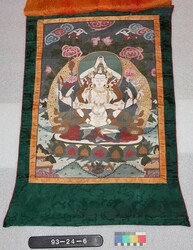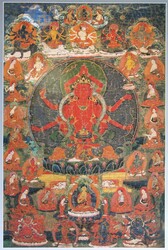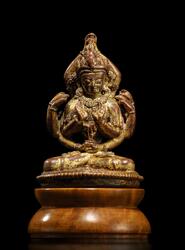
Buddhist Deity: Manjushri, Mayajala Tantra
Manjushri List of Forms PageSubjects, Topics & Types:
- Description
- Iconography
--- Original (Pre 19th century)
--- New: #36370, 77126 (Post 1826)
- Masterworks
- Secondary Figure: #83826
- Confusions
- Others…
Videos:
- Mayajala Tantra Manjushri (HAR on Patreon [15 min.])
- Namasangiti: Part 1
- Namasangiti: Part 2
- All Manjushri Videos
Mayajala Manjushri, with the 'mayajala' meaning Net of Illusion or Net of Magical Illusion referencing the 'Net of Indra,' belongs to the Yoga classification of Vajrayana Buddhist Tantra and believed to originate specifically from the Namasangiti Tantra or possibly a Mayajala parent or extended version of the tantra which appears to no longer be extant. There is however reference to a Mayajala Tantra with regard to the Guhyagarbha Tantra held in the highest regard by some of the earlier traditions of Buddhism in Tibet known as the Nyingma, but at this time there there doesn't appear to be any relationship with Mayajala Manjushri except for a shared Sanskrit name. (Also see HAR #83826).
Namasangiti Verses:
Verse 13. 'The Litany of Names extolled in the Mayajalamahatantra by unlimited delighted Mahavajradharas, bearers of mantras.'
Verse 114. 'With the great perseverance of the Māyājāla, becoming the monarch of all tantras, he
is supreme. Maintaining every cross-legged position, he bears every jñanic body.' (Donaldson).
རྒྱུད་ཆེན་སྒྱུ་འཕྲུལ་དྲ་བ་ལས། །
gyü chen gyutrul drawa lé
Which were respectfully recited in
རྡོ་རྗེ་འཆང་ཆེན་གསང་སྔགས་འཆང་། །
dorjé chang chen sang ngakchang
Illusion’s Net, the tantra most supreme,
དཔག་མེད་རྣམས་ཀྱིས་དགའ་བཞིན་དུ། །
pakmé nam kyi ga zhindu
By multitudes of mighty Vajrapāṇis,
གླུར་བསླངས་གང་ལགས་བཤད་དུ་གསོལ། །
lur lang gang lak shé du sol
The joyous guardians of secret mantras. (13, Lotsawa House)
བརྩོན་ཆེན་སྒྱུ་འཕྲུལ་དྲ་བ་སྟེ། །
tsön chen gyutrul drawa té
With great endeavours as illusory nets,
རྒྱུད་ཀུན་གྱི་ནི་བདག་པོ་མཆོག །
gyü kün gyi ni dakpo chok
The foremost master ruling every tantra,
རྡོ་རྗེ་གདན་ནི་མ་ལུས་ལྡན། །
dorjé den ni malü den
Endowed in full with every vajra posture,
ཡེ་ཤེས་སྐུ་རྣམས་མ་ལུས་འཆང་། །
yeshe ku nam malü chang
Completely furnished with all wisdom bodies, (114, Lotsawa House)
The two 19th century compositions (HAR #36370, 77126) appear to be created post the 1826 Kathmandu publication of the scholar Amritananda titled the Dharmakosasamgraha which catalogues and discusses the images and history of the Namasangiti in a one face and twelve armed form with particular gestures and attributes. In that publication only the original older style iconography is discussed which likely indicates that the alternate 19th and 20th century iconographic variation had not yet developed.
Study Topics:
- Source Texts (below)
- Chronology of Artworks
- Description
- Symbolism
Jeff Watt [updated 6-2025]
On Amṛtānanda and the Dharmakośasaṃgraha (A Synopisis)
Amṛtānanda was a Nepalese Buddhist scholar active from the 18th to the early 19th century. He was born into a scholarly Śākya family in the city of Patan (Lalitpur) in present-day Nepal. He was not only a scholar of Buddhism but also a poet, and he left behind many writings in Sanskrit, Nepali, and Newar.
Among his works, the Dharmakośasaṃgraha stands out as a text that interprets and explains sacred places, images, and other topics within the Nepalese Buddhist tradition. It is a document composed in 1826 at the request of the British diplomat Brian H. Hodgson.
Amṛtānanda was a teacher of Hodgson, instructing him in Nepalese religion, culture, and history. Hodgson later became a renowned Buddhist scholar and introduced to the world many Sanskrit Buddhist manuscripts preserved in Nepal. The discovery of these Sanskrit texts significantly advanced Buddhist studies, and it would not be an exaggeration to say that both Hodgson and Amṛtānanda played pivotal roles in enabling that progress.
In the Dharmakośasaṃgraha, Amṛtānanda includes a commentary on the image of Nāmasaṅgīti Mañjuśrī with 43 faces and 86 arms, which is the central focus of this study. However, he does not specify the exact origin of this image.
What should be noted here is that examples of the “Nāmasaṅgīti Mañjuśrī” image existed prior to the composition of the Dharmakośasaṃgraha. For instance, there is a hand-colored Sanskrit manuscript owned by a private individual titled Nāmasaṅgīti Mañjuśrī (dated 1571), as well as a stone sculpture housed in the museum on the grounds of Svayaṃbhū Mahācaitya (Swayambhūnath Stupa), dated to 1678—both of which depict this image.
From this, it can be inferred that Amṛtānanda’s explanation of Nāmasaṅgīti Mañjuśrī was based on iconographic traditions already preserved in Nepal, and that he included such traditions in his Dharmakośasaṃgraha. (Namasamgiti-Manjusri: the Iconography and its Source. Sudan Shakya)
Publications:
Toh 360. Reciting the Names of Mañjuśrī. འཇམ་དཔལ་མཚན་བརྗོད། · 'jam dpal mtshan brjod. mañjuśrīnāmasaṃgīti. (See Lotsawa House).
Dharmakosasamgraha, Amritananda. Kathmandu, 1826.
Tantric and Taoist Studies in Honour of R.A. Stein, Melanges Chinois et Bouddhiques, Michel Strickmann, editor, Vol.20 (Brussels: Institute Belge des Hautes Etudes Chinoises, 1981). The Litany of Names of Manjushri - Text and Translation of the Manjusrinamasamgiti, Ronald M. Davidson, pp. 1-69.
Religions of India In Practice, edited by Donald S. Lopez, Jr., Princeton University Press, 1995. The Litany of names of Manjushri. Ronald M. Davidson, pp.104-125.
Namasamgiti-Manjusri: the Iconography and its Source. Sudan Shakya, pages 1 to 22. The Mikkyo Zuzo (The Journal of Buddhist Iconography), Tokyo, Japan, volume 27. December, 2008.









